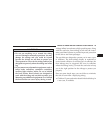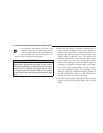
•
Infants in rear-facing child restraints must NEVER
ride in the front seat of a vehicle with a passenger front
airbag unless the airbag is turned off (Regular Cab
Vehicles Only). An airbag deployment can cause se-
vere injury or death to infants in that position. Refer to
the “Passenger Airbag On/Off Switch (if equipped)”
in this section.
•
If your vehicle does not have a rear seat, refer to the
“Passenger Airbag On/Off Switch (if equipped)” in
this section
•
Children that are not big enough to properly wear the
vehicle seat belt (refer to “Child Restraints” in this
section) should be secured in the rear seat in child
restraints or belt-positioning booster seats. Older chil-
dren who do not use child restraints or belt-
positioning booster seats should ride properly buckled
up in the rear seat. Never allow children to slide the
shoulder belt behind them or under their arms.
•
All occupants should use their seat belts properly.
•
The driver and front passenger seats should be moved
back as far as practical to allow the airbag room to
inflate.
WARNING!
•
Relying on the airbags alone could lead to more
severe injuries in a collision. The airbags work
with your seat belt to restrain you properly. In
some collisions the airbags won’t deploy at all.
Always wear your seat belts even though you have
airbags.
•
Being too close to the steering wheel or instrument
panel during airbag deployment could cause seri-
ous injury. Airbags need room to inflate. Sit back,
comfortably extending your arms to reach the
steering wheel or instrument panel.
50 THINGS TO KNOW BEFORE STARTING YOUR VEHICLE


















